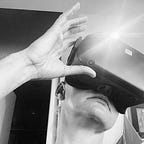Our Augmented Future (and How to Start Preparing Now)
With the wider launch of ARCore at Mobile World Congress and the increasing adoption of ARKit, not to mention developments to make augmented reality accessible via mobile browsers, an augmented future seems ever more inevitable. Five years from now, the physical and digital worlds will start to merge, and real objects will become interactive. Natural language processing and gesture recognition will develop in tandem, and our interactions with data will become more natural. We will likely see streets crowded people speaking into AR glasses and conducting the air to activate gesture-based user interfaces. Day-to-day activities will be infused with data right where it belongs. Taking off your glasses at the table will be the ultimate sign you’re paying attention to the conversation, and chiropractors will rejoice that they finally don’t have to content with text-neck as we all look up again.
While that vision is a few years out, AR on mobile phones provides plenty of opportunities to start exploring the space. There have been some excellent examples of creative AR implementation, and many more will surely follow. But simply dropping 3D objects into the real world without any purpose won’t be enough to keep users engaged, especially as more AR applications launch. There are three main ways AR is making the world more interactive, and as people start thinking about creating AR content, they should consider the following things.
- Does this present information in a more natural way?
Augmented reality provides a way to visualize data in a more cohesive way. For example, if someone is traveling to another city and wants to take public transit, they need to spend ages scrolling through different websites or consulting apps to find scheduling, price, and trip length information. In the new world, a user can be guided by information presented as a layer overlaid on the physical world, showing them an interactive schedule right at the bus stop and pointing them to when and where to get off. The added layer will strip away the clutter and one-size-fits-all information displays at the location, revealing exactly what you are looking for.
Paradoxically, we will spend less time on our phones, as we won’t have to hunt for information.
2. What are the new opportunities this can provide to users ?
Simply projecting an object on a table is fun enough, but the utility is rather limited, and after the novelty factor wears off, kind of boring. Augmented reality has many uses; there are ways for it to do everything from providing simple info to revealing different properties of objects in the world around you to more complex data visualization use cases. In the case of the former, scanning an app on a street could show you a quick hit of information about each restaurant or bar — hours, prices, wait time, etc. Rather than wandering in, looking at menus, and asking about availability, a user could have all that information served at a glance before they made any moves. In the latter case, one of the best examples is a project by acclaimed director Gabo Arora to educate Baltimore residents about women in the civil rights movement. Users walk around the city and in select locations, information pops up about rallies, speeches, and events that happened, as well as clips that let the user see the women and their work.
Enterprise, medical, and education use cases abound in this space. There are already smart glasses that allow technicians to look through someone else’s eyes, which provides opportunities for training in the field and oversight. Manuals in cars are being replaced by an app that could help find a problem and provide a step-by-step solution that even a novice could follow. There are AR apps that help practitioners find veins, and doctors will be able to visualize patient scans overlaid over their bodies, as well as seek augmented guidance from other professionals in emergency or learning situations. In education, the example in the above graph is only the beginning, and students could conceivably spend most of their time learning outside a classroom in the future.
3. Does it add digital interactivity to the world?
In twenty years, billboards will seem like a quaint relic, as the entire world becomes one targeted billboard. Advertising will start to naturally blend with real life and become less intrusive, with ads being targeted exactly to the user and presented in a way they’ll enjoy using. The ads becomes interactive and continuously changes as users interact with the content they’re seeing. And when the glasses come off, the world is a peaceful oasis. Touch screens, knobs, and advertisements will disappear, and cityscapes will be cleaner, revealing art, nature, and architecture.
There are limits to how far beyond the horizon we can peek. Apple’s founders once dreamed their machines would be used to write down recipes, and then spreadsheets came along and changed the game. On a Facebook earnings call last year, Mark Zuckerberg posited the following: “I think we’re going to get to a point where things like TVs, you no longer need a physical TV. You’ll get a $1 app that you can watch it screen on. And it will just be an interesting exercise to see how many of the things that we have that are physical things don’t actually need to be physical in that world, and how much innovation that opens up for independent developers all around the world.”
If all the world’s a stage, AR allows us to all be players in our own reality. This is the future of collaborative consumption, and we’re excited to start building it now.
